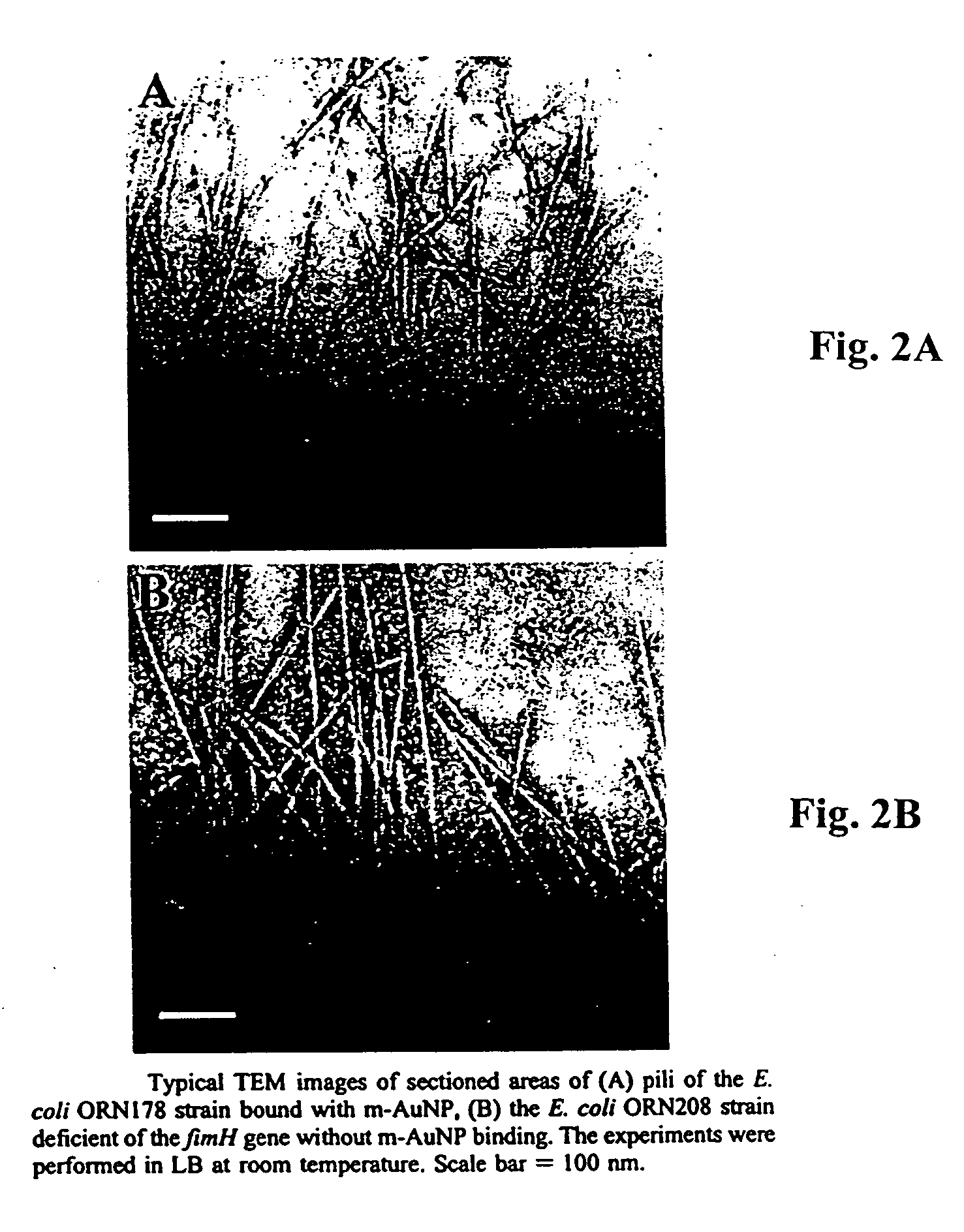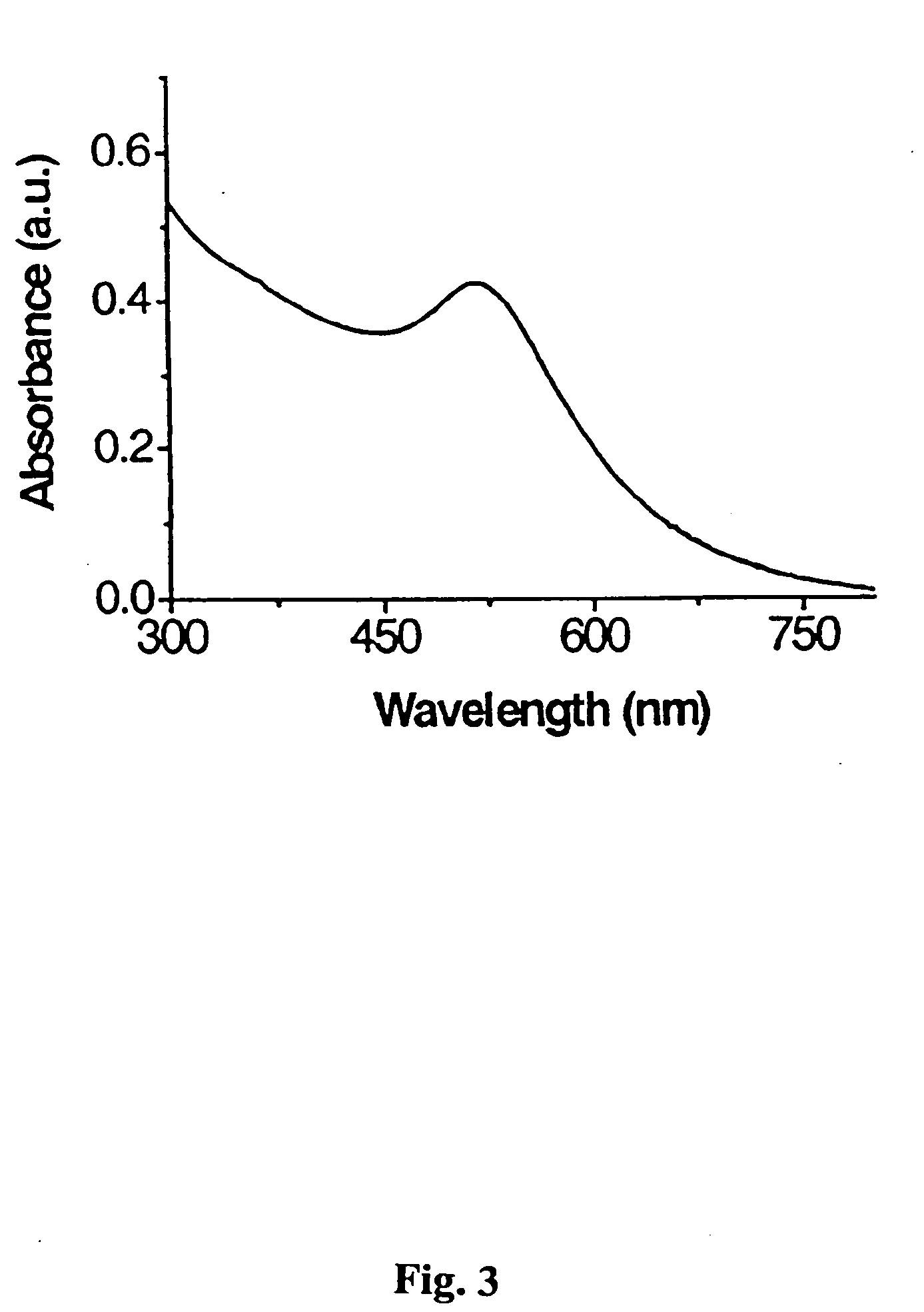Carbohydrate encapsulated nanoparticles
a technology of encapsulated carbohydrate and nanoparticles, which is applied in the field of carbohydrate encapsulated carbohydrate nanoparticles, can solve the problems of difficult synthesis of stoichiometrically defined nanoparticle-biomolecule complexes, many problems in the emerging nanoparticle field,
- Summary
- Abstract
- Description
- Claims
- Application Information
AI Technical Summary
Benefits of technology
Problems solved by technology
Method used
Image
Examples
example 1
1-Bromo 2,3,4,6-tetra-O-acetyl-mannopyranoside (Compound 2)
[0153] 2,3,4,5,6-Penta-O-acetyl-mannopyranoside (10.0 g, 25.6 mmol) was treated with HBr in AcOH (15 mL of a 33% solution) at 25° C. After stirring for 90 min, the solution was diluted with CHCl3 (100 mL) and then extracted with ice-cold H2O (200 mL×3). The organic layer was neutralized by Na2CO3, and washed with brine, dried over Na2SO4, and finally concentrated. The desired bromide (compound 2) was used for next step without further purification.
example 2
Pent-4-enyl 2,3,4,6-tetra-O-acetyl-B-D-mannopyranoside (Compound 3)
[0154] The syrup of compound 2 was co-evaporated with toluene twice before use. To a solution of compound 2 (10.0 g, 42 mmol) in toluene-acetonitrile solution (100 ml, v / v=1:1) was added derierite (5 g), 4-pentene-1-ol (4.6 mL, 59 mmol) and mercury(II) cyanide (12.0 g, 47.5 mmol). The mixture was stirred overnight at room temperature and then filtered. The resulting residue was dissolved in chloroform (100 mL) and washed with NaCl(sat). The organic layer was dried over Na2SO4, filtered and concentrated. The residue was purified by a flash column chromatography (EtOAc / hexane=1 / 1) to give compound 3 (8.4 g) in 88% yield. 1H NMR (400 MHz, CDCl3) δ 1.69-1.76 (m, 2H), 2.00 (s, 3H), 2.05 (s, 3H), 2.09-2.21 (m, 2H), 2.10 (s, 3H), 2.16 (s, 3H), 3.47 (dt, J=13.2, 6.4 Hz, 1H), 3.70 (dt, J=13.2, 6.4 Hz, 1H), 3.99 (ddd, J=10.0, 5.2, 2.8 Hz, 1H), 4.1 1(dd, J=12.0, 2.8 Hz, 1H), 4.27 (dd, J=12.0, 5.2 Hz, 1H), 4.80 (d, J=1.6 Hz, 1H...
example 3
5-Thioacetoxypentyl 2,3,4,6-tetra-O-acetyl-α-D-mannopyranosyl Dimer (Compound 4)
[0155] A solution of compound 3 (500 mg, 1.15 mmol), thioacetic acid (0.5 mL, 0.85 mmol), and AIBN (95 mg, 0.1 mmol) in 1,4-dioxane (20 mL) was thoroughly degassed (N2) before being reacted at 75° C. After stirring for 6 h, the reaction was quenched with cyclohexene (3 mL), concentrated and co-concentrated twice with toluene. The residue was then subjected to flash chromatography (EtOAc / hexane=1 / 1) to yield sulfide spacer derivative (460 mg, in 80% yield). 1H NMR (400 MHz, CDCl3) δ 1.42-1.48 (m, 2H), 1.58-1.66 (m, 4H), 2.00 (s, 3H), 2.05 (s, 3H), 2.11 (s, 3H), 2.16 3H), 2.34 (s, 3H), 2.89 (t, J=7.2 Hz, 2H), 3.45 (dt, J=12.8, 6.4 Hz, 1H), 3.69 (m, J=13.2, 6.4 Hz, 1H), 3.96-4.00 (m, 1H), 4.11(dd, J=12.4, 2.4 Hz, 1H), 4.29 (dd, J=12.4, 5.2 Hz, 1H), 4.80 (d, J=1.6 Hz, 1H), 5.23-5.31 (m, 2H), 5.33 (dd, J=10.0, 6.8 Hz, 1H); 13C NMR (100 MHz, CDCl3) 620.36×2, 20.73×2, 24.37, 28.28, 28.81, 28.98, 30.76, 61.82, ...
PUM
| Property | Measurement | Unit |
|---|---|---|
| Diameter | aaaaa | aaaaa |
| Diameter | aaaaa | aaaaa |
| Metallic bond | aaaaa | aaaaa |
Abstract
Description
Claims
Application Information
 Login to View More
Login to View More - R&D
- Intellectual Property
- Life Sciences
- Materials
- Tech Scout
- Unparalleled Data Quality
- Higher Quality Content
- 60% Fewer Hallucinations
Browse by: Latest US Patents, China's latest patents, Technical Efficacy Thesaurus, Application Domain, Technology Topic, Popular Technical Reports.
© 2025 PatSnap. All rights reserved.Legal|Privacy policy|Modern Slavery Act Transparency Statement|Sitemap|About US| Contact US: help@patsnap.com



